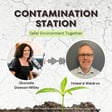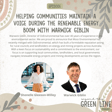
Groundwater Contamination with Dr Danielle Toase and Dr Lange Jorstad
In this episode, Shonelle chats with two special guests, Dr Danielle Toase and Dr Lange Jorstad.
Danielle Toase is an Environmental Manager, with a BSc in environmental science and PhD in environmental geochemistry. She has over 10 years experience across the fields of environmental research, regulation, remediation contracting, consulting and corporate environmental management.
Danielle has worked at multiple complex PFAS contamination since 2016, particularly at aviation sites or sites where multiple sources of PFAS exist. Her interests surround PFAS fingerprinting, source delineation, remediation technologies and the circular economy. Danielle is also an active member of ALGA, having recently been appointed to the Board of Directors and is an honorary research associate at Macquarie University.
Lange Jorstad is a Principal Hydrogeologist at Geosyntec Consultants, with a BSc in geological sciences from the University of California, Santa Barbara, and a PhD in contaminant hydrogeology from UNSW. He has over 20 years’ experience as a consulting hydrogeologist, specialising in contaminant fate and transport and environmental geochemistry.
Lange is a NSW EPA accredited Site Auditor and Certified Environmental Practitioner – Site Contamination Specialist, is an active member of the ALGA groundwater fate and transport special interest group, and provides university lectures on groundwater, contamination and sustainable remediation. He has provided consulting and auditing services for PFAS-contaminated properties for government and industry clients since 2015, including local development sites, fuel terminals, landfills, and airports.
You’ll hear how they got started in their respective fields, including Danielle’s PhD studies in Antarctica focused on chemical fixation of heavy metals in legacy landfills using orthophosphate and silica reagents.
Lange shares advice for local councils investigating landfills as a contamination source, and the evolution of groundwater remediation from pump and treat to in situ technologies, and Danielle discusses the purpose of PFAS fingerprinting and why it’s important especially in complex hydrogeology and sites with multiple potential sources of PFAS.



















